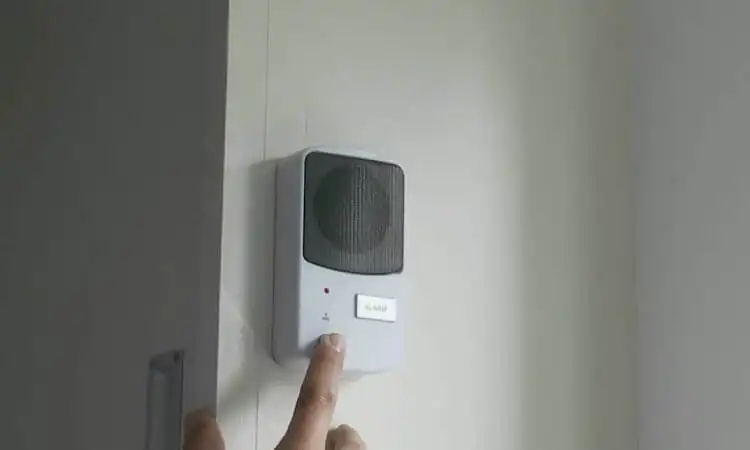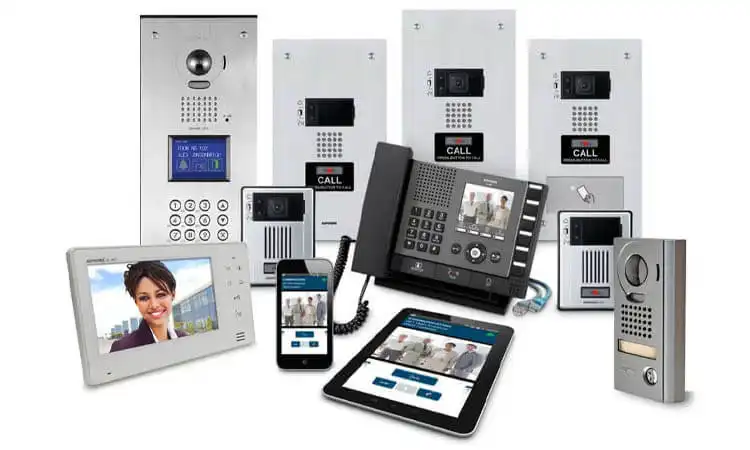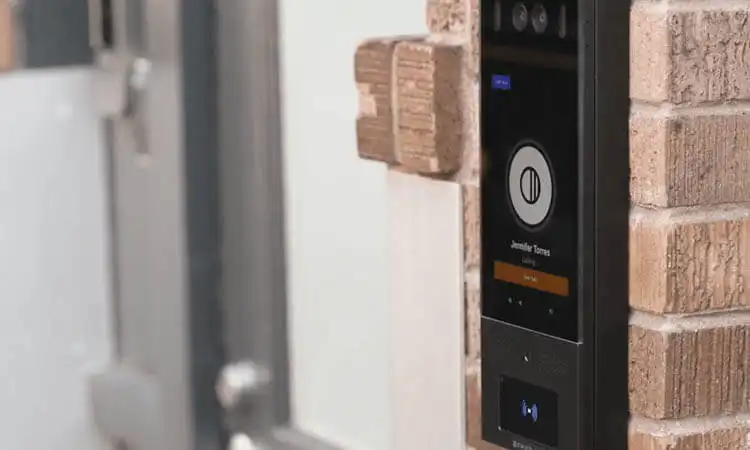Are you considering a more advanced and convenient way to monitor your home’s entryway? A wireless intercom doorbell might be the perfect solution for you. These systems provide a range of features, such as two-way audio and smartphone connectivity. These features offer significant benefits over traditional doorbells. Whether you want to enhance your home’s security, improve your daily routine, or modernize your home’s technology, a home wireless intercom system is a versatile and efficient solution.
What is a Doorbell Intercom?
A doorbell intercom is a communication system that allows you to see and talk to visitors at your front door without opening it. It combines a doorbell and an intercom system that allows two-way communication between the outside and inside of your home. The system comprises a camera, microphone, speaker, and doorbell button. When a visitor presses the button, a chime rings inside the house, and the camera activates to show a live video feed of the person at the door. Then, you can speak to the visitor using the built-in microphone and speaker.
Doorbell intercoms come in both wired and wireless versions. Wired intercom systems connect components with physical wires. Wireless systems use Wi-Fi or Bluetooth to communicate between devices. Doorbell intercoms have different features, such as motion detection and remote access. Some advanced systems can even integrate with smart home devices. These allow you to control your front door from your smartphone or voice assistant.
Doorbell Intercoms are Beneficial for Several Reasons:
- They provide an additional layer of security to homes. The doorbell intercom system allows you to screen visitors before opening the door.
- They also offer the convenience of communicating with your visitors from any location, even when not on-site. This means you can communicate with delivery drivers or guests when you’re not home. This ensures that important packages and visitors are not missed.
- Doorbell intercoms are an effective way to deter unwanted visitors, such as burglars or package thieves. This is because the camera captures their images; you can share the footage with law enforcement if needed.
- Doorbell intercoms can help visitors with disabilities or limited mobility gain easier access to your home. They can communicate with you from outside your home without climbing stairs or navigating uneven terrain.
How to Tell if Your Doorbell Intercom is Wired or Wireless?
If you’re unsure about whether your doorbell intercom system is wired or wireless, there are a few things you can do to figure it out. Here are some tips to help you identify the type of intercom system you have:
- Look for visible wiring: If wires run between the indoor and outdoor units, you likely have a wired intercom system. Inspect the exterior of your home and look for visible wiring around the doorbell button or intercom unit.
- Check the installation manual: The product specifications section may provide information about whether the intercom system is wired or wireless. This is an easy way to determine the type of system you have.
- Check the power source: A wired intercom system typically requires a power source like a transformer to power the intercom and doorbell buttons. Check your electrical panel to see if there is a dedicated circuit breaker for the doorbell intercom system.
- Look for battery compartments: Wireless intercom systems typically have batteries powering the outdoor unit. You likely have a wireless system if you see battery compartments in the outdoor unit or doorbell buttons.
- Check the range: Wireless intercom systems are limited. If you can communicate with the outdoor unit significantly from your home, you will likely have a wired system.
These methods allow you to identify whether your intercom system is wired or wireless easily. Knowing the type of system you have can help you troubleshoot any issues and determine what upgrades or replacements you may need.
Wired vs. Wireless Doorbell Intercom
Regarding doorbell intercoms, you have two options: wired or wireless. The choice between them depends on personal preference and specific needs. Here are wired and wireless doorbell intercom pros and cons:
Wired Doorbell Intercoms:
- They are more reliable as they are not susceptible to interference or signal loss
- They are more secure, as they cannot be hacked remotely.
- Better video and audio quality
- Require professional installation and are more expensive.
- Draw power from existing doorbell wiring.
Wireless Doorbell Intercoms:
- Easy to install. This is because they do not require any wiring.
- Easy to carry. You can move it from one place to another.
- More flexible and have advanced features.
- Susceptible to interference or signal loss.
- Lower video and audio quality, depending on the strength of the wireless signal.
- Require batteries or an external power source.
Here is a Table Comparing Wired and Wireless Doorbell Intercoms:
| Feature | Wired Doorbell Intercom | Wireless Doorbell Intercom |
|---|---|---|
| Installation | Requires wiring and cables | Easy to install, no wiring required |
| Range | Limited by wiring and cables | Unlimited range (depending on wireless technology) |
| Mobility | Fixed location | Portable and can be moved around easily |
| Interference | Minimal interference | Can be affected by physical obstacles and wireless interference |
| Cost | More expensive to install | Less expensive to install |
| Maintenance | More difficult to maintain | Easier to maintain |
| Security | More secure due to wired connection | Can be less secure due to wireless vulnerabilities |
| Compatibility | May require additional hardware | Compatible with most devices and platforms |
| Features | Basic features | Advanced features available |
Before choosing between a wireless and wired doorbell intercom, you should consider their needs and budget. Wired systems are a better long-term investment and ideal for those prioritizing reliability and security. Wireless systems are more affordable and easier to install, making them a better fit for renters or older homes.
Understanding the Differences Between Doorbells and Intercoms
Doorbell and intercom are two terms that are often used interchangeably, but they refer to different types of systems. While both devices alert homeowners of a visitor at the door, intercoms provide a layer of communication and security.
A doorbell is a straightforward device that alerts homeowners of the presence of a visitor at their door. It typically consists of a button outside the door and a chime inside the home that sounds when the button is pressed. Modern doorbells may include more features, but their primary function is to alert homeowners of a visitor’s presence.
Here’s a Table Outlining the Main Differences Between a Doorbell and an Intercom System:
| Feature | Doorbell | Intercom |
|---|---|---|
| Function | Notifies when someone is at the door | Allows for two-way communication with visitors |
| Communication | One-way communication from the door to the inside | Two-way communication between the inside and outside |
| Mobility | Not easily movable, fixed to a specific location | Portable, can be moved to different locations |
| Audio/Video | May have audio and/or video capabilities | Typically has audio and video capabilities |
| Installation | Easy to install, typically requires wiring | More complex to install, may require additional wiring or infrastructure |
| Cost | Generally less expensive than intercom systems | Generally more expensive than doorbell systems |
| Security | Basic security features such as door chimes | Often includes more advanced security features such as video recording and remote access |
| Applications | Primarily used for residential door notification | Used for residential, commercial, and industrial applications |
In contrast, an intercom is a two-way communication system. This enables you to speak with visitors before opening the door. It typically consists of a base station inside the home and a speaker or camera outside the door. Intercoms may also have advanced features like video recording or smart home system integration.
Mesh Intercom vs. Bluetooth Intercom
Intercom systems come in two primary types: mesh intercoms and Bluetooth intercoms. Mesh intercoms use a mesh network where every device functions as a node in the network. This allows communication over long distances and in areas with poor cellular reception. This makes mesh intercoms popular among motorcyclists and outdoor enthusiasts who must communicate over long distances. They also have longer battery life and can support more users than Bluetooth intercoms.
On the other hand, Bluetooth intercoms use Bluetooth technology, which is ideal for short-range communication. They are popular among athletes such as cyclists and runners who need to communicate with others nearby. Bluetooth intercoms typically have better audio quality than mesh intercoms, but their range is limited to a few hundred feet. Additionally, Bluetooth intercoms are usually more affordable than mesh intercoms.
Both mesh and Bluetooth intercoms can have additional features like voice control and music streaming. However, mesh intercoms typically have more advanced features like GPS tracking and group chat.
Here’s a Table Comparing Mesh Intercom and Bluetooth Intercom Systems:
| Feature | Mesh Intercom | Bluetooth Intercom |
|---|---|---|
| Range | Typically has a longer range, as each device acts as a repeater to extend the signal | Limited range, usually up to 1/4 mile depending on the model |
| Connection | Connects multiple devices in a mesh network | Connects two devices directly |
| Quality | Provides better audio quality in larger groups | Audio quality may suffer in larger groups |
| Battery Life | Generally longer battery life | Battery life may be shorter due to constant Bluetooth connection |
| Pairing | Devices automatically pair with others in the network | Devices must be manually paired with each other |
| Interference | Less susceptible to interference from other devices | May be susceptible to interference from other Bluetooth devices |
| Cost | Generally more expensive than Bluetooth intercoms | Generally less expensive than mesh intercoms |
| Additional Features | Often includes advanced features such as voice-activated controls and GPS tracking | Fewer additional features available |
Ultimately, the choice between mesh and Bluetooth intercoms depends on the user’s needs. They may prefer a mesh intercom if they need to communicate over long distances or in areas with poor cellular reception. However, Bluetooth intercoms may be more suitable if they require short-range communication. Furthermore, users may prefer a mesh intercom if they prioritize advanced features. While if they focus on affordability, they may prefer a Bluetooth intercom.
Wireless Communication vs. Wired Communication
Wireless and wired communication are the two main methods of transmitting information. Wireless communication uses electromagnetic waves to transfer data without physical connections. Wired communication utilizes cables to send data. Wireless communication is more flexible and convenient. This is because it eliminates the need for physical cables. It is commonly used in various applications like mobile phones, laptops, and Wi-Fi networks. On the other hand, wired communication is more secure and reliable because it is less susceptible to interference and hacking. It is typically used in desktop computers, servers, and telecommunications networks.
Wireless communication has its limitations, as it can be affected by signal strength and interference. In contrast, wired communication can be limited by cable length and distance. The choice between wireless and wired communication depends on the user’s needs and requirements.
Here’s a Table Comparing Wireless and Wired Communication:
| Feature | Wired Communication | Wireless Communication |
|---|---|---|
| Installation | Typically requires extensive wiring and cabling | Easier and quicker to install, minimal wiring required |
| Range | Limited range, typically only covers a specific area or room | Longer range, can cover larger areas and multiple rooms |
| Mobility | Not easily movable, fixed to a specific location | Portable, can be moved to different locations |
| Security | Generally considered more secure, as wired signals are more difficult to intercept | Wireless signals may be more vulnerable to interception, but encryption can improve security |
| Reliability | More reliable, as wired connections are less susceptible to interference or signal loss | May be less reliable, as wireless signals can be affected by interference, obstacles, or distance |
| Speed | Generally faster, as wired connections can support higher bandwidth and more data transfer | Slower, as wireless connections may be limited by bandwidth and signal strength |
| Maintenance | More difficult to maintain and troubleshoot, may require professional assistance | Easier to maintain and troubleshoot, can be done by the user with basic knowledge |
| Cost | Generally less expensive than wireless communication | Generally more expensive than wired communication |
| Additional Features | Fewer additional features available | Often includes advanced features such as remote access and control, and compatibility with smart home systems |
Wireless communication is an excellent option if flexibility and convenience are top priorities. However, wired communication is recommended if security and reliability are more important.
Why do I Need a Wireless Intercom Doorbell?
A wireless doorbell intercom is an essential device that benefits homeowners and business owners. Here are some reasons why you might need a wireless intercom doorbell:
- Convenience: A wireless intercom doorbell allows you to communicate with visitors without physically going to the door. This can be especially useful when you’re busy with household chores or work.
- Security: A wireless doorbell intercom can enhance the security of your home or business. It can allow you to screen visitors before granting access. This can help you avoid potential threats and intruders. It makes the elderly or disabled communicate with visitors without answering the door themselves.
- Flexibility: The wireless doorbell intercom is easy to install. You can place it anywhere within the range of the device. It allows you the flexibility to choose the most appropriate location.
- Additional Features
A wireless intercom doorbell can provide a safe and secure environment for your home or business. Its many benefits include convenience, security, safety, flexibility, and additional features. These make it an excellent investment for any property owner.
Essential Features to Look for in a Wireless Intercom Doorbell
- Two-Way Communication. Communication, A crucial feature of a wireless intercom doorbell is the ability to have a two-way conversation with visitors. This allows you to communicate effectively and gather necessary information before opening the door.
- High-Definition Video. Opt for a doorbell with high-definition video quality to get a clear and detailed view of visitors. This feature is especially useful for identifying individuals or capturing important details like license plate numbers.
- Night Vision Capability. Consider a wireless intercom doorbell with night vision capability to ensure visibility during low-light conditions or at night. This feature provides added security and convenience, allowing you to monitor your front door anytime.
- Motion Detection. Choose a doorbell that includes motion detection sensors. This feature alerts you when someone approaches your door even before they press the doorbell button. It provides an additional security layer and helps you track any activity near your front entrance.
- Smartphone App Integration. Look for a wireless intercom doorbell that offers a dedicated smartphone app. This allows you to receive notifications, view live video feeds, and interact with visitors remotely, even when you’re not at home. It provides flexibility and convenience, giving you control over your front door from anywhere.
- Cloud Storage for Recordings. Consider a doorbell that offers cloud storage for recorded videos. This feature ensures that you can review past events or suspicious activities anytime. Look for options that provide free or affordable cloud storage plans to accommodate your needs.
Factors to Consider When Choosing a Wireless Intercom Doorbell
When selecting a wireless intercom doorbell system, several important factors must be considered. Here are some key factors to keep in mind:
- Consider range and coverage. Ensure your doorbell and receivers can provide a strong, consistent connection across the area you need to monitor. Larger homes require a longer range for full coverage.
- Compatibility is key. Choose a system that fully integrates with your existing doorbell setup. No extra installation or modification should be needed.
- Choose useful features. Decide what capabilities will enhance your security, like video monitoring, motion detection, two-way audio, remote access, etc. Select features that provide value.
- Select a compatible power source. Get a system powered by batteries, hardwired electricity, or a hybrid. Ensure it can support all components without power issues.
- Consider aesthetics. Choose a system with a style that enhances your home’s curb appeal and architecture. A discreet, seamless design has the least visual impact.
- Get a reputable, trusted brand. Read reviews to validate quality, durability, and dependability. With a monitor at your entrance, reliability matters.
- Weigh costs and value. Budget-friendly, high-value and premium options are available. Compare to get essential useful features at an optimal price point for your needs.
- Opt for easy DIY installation. Look for a simple system that can be set up quickly without complex wiring or technical expertise. Clear instructions and all hardware ensure a simple, trouble-free installation.
Evaluating options on these key points will lead you to a wireless intercom doorbell system that enhances your security, convenience, and safety while complementing your home’s style. Choose a system tailored to your needs, requirements, and expectations for an integrated, intelligent entrance solution.
How does a Wireless Intercom Doorbell Work?
Wireless intercom doorbells consist of two main components: the outdoor unit with a camera and microphone and the indoor unit with a speaker and display. When visitors press the doorbell button, the camera captures their image, and the microphone transmits their voice to the indoor unit. Homeowners can then see and speak to the visitor through the indoor unit.
A doorbell intercom wireless technology uses radio waves to transmit an audio signal from the doorbell unit to a portable cell phone. A sequence of processes occurs when a visitor presses the doorbell or triggers a motion sensor. Signals will be sent and received via the portable handset. This produces an audible prompt or a visual alarm. The user can then communicate with the visitor through the speaker/microphone unit. The user can also listen to the visitor’s response through the speakerphone or earphone of the portable phone.
Wireless doorbells use specific frequency bands, such as 900 MHz, 2.4 GHz, or 5.8 GHz, to send signals. These devices can also connect to other devices using Wi-Fi or Bluetooth technology. They primarily use digital encryption to prevent eavesdropping or interference by other wireless devices.
Wireless intercom doorbells are available in both wired and wireless configurations. The latter is more popular for its ease of installation and flexibility. They suit various environments, including homes, offices, and other commercial facilities. They provide effective and convenient communication, especially when wiring is unsuitable.
How to Use Wireless Intercom Doorbell

Doorbell wireless intercoms are convenient and user-friendly way. You can use it to communicate with visitors and enhance the security of your home or business. Here are some steps to effectively use a wireless intercom doorbell:
- Step 1: Follow the manufacturer’s instructions to install the intercom doorbell system. Typically, this involves mounting the speaker/microphone unit on or near the door and pairing it with the portable handset.
- Step 2: The intercom system activates when someone presses the doorbell button or triggers the motion sensor. Then, it will transmit an audio signal to the portable handset. This will result in an audible chime or visual alert on the handset.
- Step 3: Pick up the portable handset and speak into the microphone to communicate with the person at the door. The visitor’s response can be heard through the speaker or headset of the portable handset.
- Step 4: If desired, use the integrated door release function (if available) or manually open the door to allow entry.
- Step 5: End the conversation by pressing the appropriate button on the portable handset or switching off the device when finished.
Systems that Can be Integrated with Wireless Intercom Doorbell

Wireless intercom doorbells can be integrated with various systems to increase their versatility and functionality. Here are some examples:
Smart Home Systems
Doorbell wireless intercoms can be connected to smart home systems like Amazon, Alexa, or Google Assistant. This allows users to control the doorbell with their voice, receive alerts on their smart devices, and even view the video feed on their smart TV.
Home Security Systems
Integrating wireless intercom doorbells with home security systems can provide an extra layer of security. The home security system can be triggered to start recording video footage when someone presses the doorbell. It will sound an alarm or send alerts to your smartphone.
Access Control Systems
Wireless intercom doorbells can be integrated with access control systems. This enables users to communicate with visitors before granting them access to the property.
Home Automation Systems
Integrating doorbell wireless intercoms with home automation systems allows for task automation. These home automation systems can be Control4 or Crestron. For example, you can set up a rule that automatically turns on the porch lights when the doorbell is pressed after dark.
Video Surveillance Systems
Intercom wireless doorbell can be integrated with video surveillance systems to provide a complete security solution. You can view live video feeds from doorbell intercom with camera and recorded footage from other cameras around their property.
You can create a comprehensive home security and automation solution tailored to your needs by integrating with them.
In addition to the systems mentioned above, doorbel l wireless intercoms can be integrated with music and video doorbells. Some wireless intercom doorbells have built-in speakers. They can be connected to a music system to play music throughout the home or business. Moreover, wireless video intercom doorbell allows users to see who is at the door before answering it. This feature can be integrated with other wireless video doorbell intercom system to provide a more comprehensive view of the property.
Choose the Best Wireless Doorbell Intercom System

Choosing the best wireless doorbell intercom system can be overwhelming, with so many options on the market. There are several key factors to consider to make the process easier.
- First, consider the range of the intercom system. The range should cover the distance between the front door and the receiver location for effective communication.
- Second, evaluate the audio and video quality of the system. Look for a system that provides clear, high-quality audio and video to ensure easy communication with visitors.
- Third, consider the ease of installation and use. Choose a system that is user-friendly and easy to install and set up, even if you are not tech-savvy.
- Fourth, evaluate the power source and battery life of the system. Look for a system with a long battery life that is easily charged or replaced to ensure that the system is always operational when needed.
- Lastly, consider additional features. These can improve the security and convenience of intercom systems.
Some of the Best Wireless Doorbell Intercom Systems in the Market Include:
- Ring Video Doorbell Pro,
- Nest Hello,
- Arlo Audio Doorbell
- and August Doorbell Cam Pro.
Wireless intercom doorbells are widely available for online and in-store purchases. Online stores offer a variety of options at different prices from retailers such as Amazon, Best Buy, Home Depot, and Lloyds. Prices range from about $30 for a basic model to more advanced systems costing over $200.
Wireless intercom doorbell systems can bring many benefits to users. However, the best system will depend on the specific needs and preferences of the user. You can ensure that the system you choose is reliable by researching and reading reviews from other customers.
About Wireless Intercom Doorbell FAQs
-
What is a wireless intercom doorbell, and how does it work?
A wireless intercom doorbell is an electronic device that allows homeowners to communicate with visitors at their front door using a wireless intercom system. The doorbell works by transmitting a signal from the doorbell button to a receiver or intercom unit located inside the home.
-
What are the key features of a wireless intercom doorbell, and how do they benefit homeowners?
The key features of a wireless intercom doorbell include two-way communication, video monitoring, and the ability to unlock the door remotely. These features provide homeowners with added security, convenience, and peace of mind.
-
What are the differences between a wireless intercom doorbell and a traditional wired doorbell?
The main difference between a wireless intercom doorbell and a traditional wired doorbell is that a wireless doorbell does not require any wiring to be installed in the home. Instead, the doorbell and intercom units communicate wirelessly using radio frequencies.
-
How easy is installing a wireless intercom doorbell, and what tools are required?
Installing a wireless intercom doorbell is relatively easy and typically requires only a few basic tools, such as a screwdriver and drill. The doorbell and intercom units can be mounted using adhesive strips or screws, and the wireless receiver can be plugged into any electrical outlet in the home.
-
Can multiple wireless intercom doorbells be installed in a single home, and how do they interact with each other?
Yes, multiple wireless intercom doorbells can be installed in a single home, and they can be set up to communicate with each other using a wireless network.
-
How is a wireless intercom doorbell compatible with my home’s existing doorbell system?
Most wireless intercom doorbells can be installed without additional wiring or modifications to the home’s doorbell system. However, checking the product specifications and compatibility requirements before purchasing is always recommended.
-
How do I troubleshoot common issues with a wireless intercom doorbell, such as connectivity problems or low battery life?
It is recommended to refer to the product manual or contact the manufacturer for assistance in troubleshooting common issues with a wireless intercom doorbell. Common solutions may include resetting the system, checking the battery life, and adjusting the wireless signal strength.
-
Are wireless intercom doorbells easy to install?
Most wireless intercom doorbells are easy to install and can be done without professional help. They usually come with instructions and mounting hardware that makes it easy to install the unit yourself.
-
Can I connect my wireless intercom doorbell to my smartphone?
Many modern wireless intercom doorbells can be connected to your smartphone through a mobile app. This feature allows you to monitor your doorbell and communicate with visitors from anywhere using your smartphone.
-
Is the wireless intercom doorbell waterproof?
Many wireless intercom doorbells are designed to be weather-resistant. They can withstand various weather conditions, including rain and snow. However, not all wireless intercom doorbells are completely waterproof. So you must check the product specifications before purchasing is important. Some models may have an IP rating indicating their water resistance level, such as IP44 or IP65. It is recommended to choose a wireless intercom doorbell with a high IP rating if installed in an area exposed to rain or other moisture. In addition, you will need to maintain the unit regularly. This includes ensuring the battery compartment is properly sealed and checking for signs of water damage.










